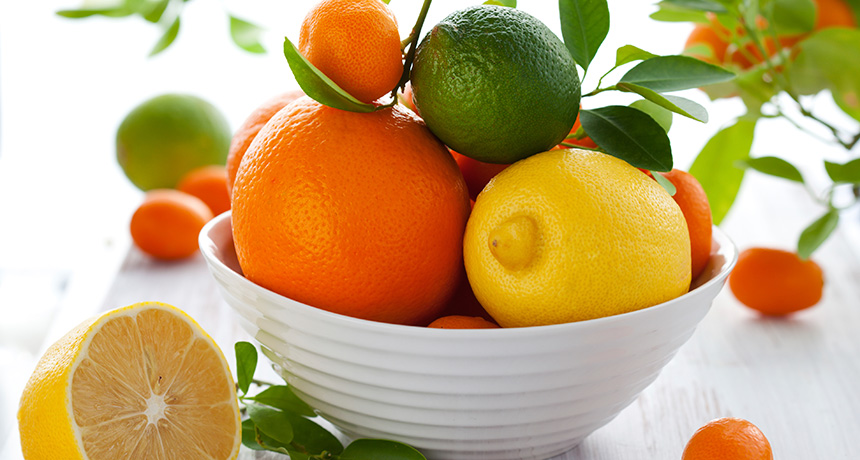
CITRUS BOWL The most detailed genetic analysis of citrus fruits to date reveals the maternal lineage and hints about who the daddies of some hybrid varieties might have been.
Sarsmis/iStockPhoto
- More than 2 years ago
The mother of all citrus plants lived about 13 million years ago, scientists have learned by tracing the maternal side of the citrus family tree. Yet it is dad’s contribution that has revealed the growing family’s entire portrait.
Starting about 8.08 million years ago, the citrus family tree began branching out. That’s when Australian limes and citrons split from the original Citrus genus, researchers report April 14 in Molecular Biology and Evolution. Several subsequent rounds of speciation led to branches carrying lemons, limes, oranges, tangerines and other citrus fruits. Learning how these species and varieties evolved may help breeders devise new varieties that can withstand drought and disease while still making tasty fruit, scientists say.
Researchers from Valencia, Spain, determined the genetic makeup of chloroplasts — organelles in plant cells that carry out photosynthesis — from 30 types of citrus. It’s the most detailed genetic analysis ever of citrus plants.
Chloroplasts carry their own DNA, containing more than 100 genes that encode proteins important for photosynthesis. These organelles are typically inherited from the female parent. That’s how researchers traced citrus plants’ heritage back to their maternal root in Asia 13 million years ago.
But the new study also yielded paternal information, says study coauthor Joaquin Dopazo, a bioinformatician at the Prince Felipe Research Center.
Dopazo and colleagues noticed that many of the plants had more than one type of chloroplast DNA in their cells, a phenomenon known as heteroplasmy. The extra chloroplasts came from male plants when two species of citrus hybridized, the researchers determined.
The study bolsters the controversial idea that plants can inherit organelles from male parents, says Cynthia Morton, a molecular systemicist at the Carnegie Museum of Natural History in Pittsburgh. Previously, scientists had used scant data — only a few genes from chloroplasts — as evidence of heteroplasmy, leaving room for debate. This study compiled the complete chloroplast chromosome — including 133 genes and the stretches of DNA in between — leaving little doubt that heteroplasmy happens often in citrus, Morton says. “The facts are much stronger. The data are much stronger,” than in previous studies, she says.
Dopazo and colleagues used the heteroplasmy information to identify both parents of hybrid species. For instance, the analysis confirmed that sweet oranges are the offspring of a pomelo female and a mandarin male. Lemons resulted when a sour orange female hybridized with a citron.
Such hybridization is an evolutionary shortcut to making new species, Dopazo says. “Otherwise you’d have to wait millions of years” to accumulate enough genetic variation to make new species.
Citrus has also been building variation without hybridization, Dopazo and colleagues found. For instance, Australian limes got an evolutionary advantage from variants in two genes, matK and ndhF, the researchers report. Mandarins’ evolutionary success stems in part from mutations in the ccsA gene. Changes in the ycf1 gene were also found to give an evolutionary edge to citrus on the branch of the family tree that contains mandarins and related fruits, such as the Philippine samuyao and the wild Mangshan mandarin, the researchers report. It’s not clear what advantage those genes provide.
The variation that the Spanish team saw could mean those genes are unimportant, not an evolutionary boon, says Henry Daniell, a chloroplast molecular biologist and genetic engineer at the University of Pennsylvania School of Dental Medicine in Philadelphia. For instance, plants don’t need ndhF to survive, he says. “These guys may be barking up the wrong tree in their assertion.”
The ability to track hybridization may help save citrus plants from citrus greening, a serious plant disease that is threatening citrus orchards across the southern United States, Morton says. Some citrus varieties in Asia, where citrus greening originated, may be immune to the insect-borne disease. Breeders may be able to re-create hybrid species, this time using greening-resistant parents. Chloroplast DNA could quickly tell the breeders whether their crosses have produced the desired hybrid.
Editor’s note: This story was updated on April 24, 2015, to remove Australian limes as possible parents of lemons. And due to a disparity between the manuscript provided to journalists and the final published paper, the date that Australian limes and citrons split from the rest of citrus has been updated to 8.08 million years ago, not 7.5 million as originally stated.







